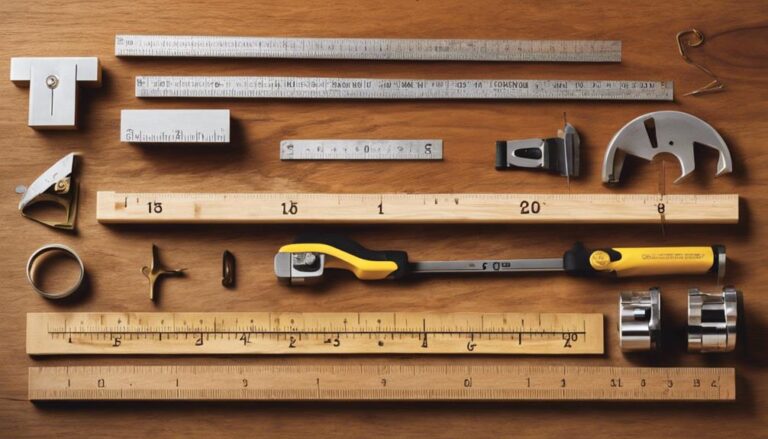Have you ever considered how the right safety gear can be the difference between a productive day in the workshop and an unplanned trip to the emergency room?
As a carpentry equipment user, you’re no stranger to the hazards lurking among the sawdust and noise. You know the importance of shielding your eyes with safety goggles and protecting your hearing with earmuffs, but there’s more to safety gear than meets the eye.
From respiratory protection to cut-resistant gloves and steel-toe boots, each piece plays a crucial role. Let’s explore the essentials, and perhaps uncover a few items you hadn’t considered indispensable to your safety arsenal.
Contents
Essential Protective Eyewear

When engaging in carpentry, wearing protective eyewear isn’t just advisable; it’s essential for safeguarding your vision from wood particles and debris. Safety goggles specifically designed for woodworking provide wrap-around protection, ensuring that even the smallest wood pieces can’t reach your eyes.
This is crucial for maintaining clear vision, which is indispensable for safe operation within the workshop. For those requiring corrective lenses, prescription safety glasses offer a dual benefit of enhanced protection while accommodating vision needs.
It’s important to note that regular glasses fall short in offering the necessary coverage against potential hazards. Therefore, investing in dedicated safety equipment like protective eyewear is a non-negotiable aspect of your safety protocol in carpentry, effectively shielding your eyes from risks associated with woodworking tasks.
Respiratory Safety Gear

Inhaling harmful wood dust particles poses a significant threat to your respiratory health, making the use of respiratory safety gear such as dust masks and respirators indispensable for anyone using carpentry equipment.
Dust masks with a P100 rating are specifically designed to effectively filter out sawdust and other airborne particles, offering you sawdust protection that safeguards your lungs from the dangers of harmful wood dust. It’s crucial for maintaining a safe and healthy work environment in carpentry.
Investing in quality respiratory protection isn’t just about compliance; it’s about ensuring long-term respiratory health. Proper selection and use of woodworking safety equipment are fundamental in preventing respiratory issues and minimizing health risks associated with woodworking activities.
Hearing Protection Devices

Just as protecting your lungs from harmful dust is crucial, safeguarding your hearing from the high decibels produced by carpentry equipment is equally imperative.
The Noise Reduction Rating (NRR) of hearing protection devices should be at least 20 dB to effectively reduce noise. Earplugs and earmuffs are essential in preventing hearing damage from loud power tools.
It’s vital to select hearing protection devices based on comfort and fit, ensuring they’re worn consistently during woodworking tasks to protect your hearing health.
Furthermore, Bluetooth-enabled earmuffs offer both convenience and protection, allowing you to listen to music while blocking out harmful noise.
Just as dust masks and respirators keep dust particles at bay, earplugs and Bluetooth-enabled earmuffs serve as a barrier against the cacophony of carpentry, maintaining your auditory well-being amidst a lot of dust and noise.
Hand and Footwear Protection
Protecting your hands and feet with the right gear is as crucial as safeguarding your hearing and lungs in carpentry. Steel toe boots are a fundamental component of your protective equipment (PPE), shielding you from falling objects and sharp tools. They’re not just about protection; they also contribute to your stability, reducing the risk of slips and falls during intricate carpentry tasks.
| Feature | Benefit |
|---|---|
| Steel Toe | Protects feet from impact and compression |
| Puncture-Resistant Soles | Prevents injuries from sharp objects |
| Leather Work Boots | Offers durability and comfort |
Investing in quality footwear isn’t just about safety; it’s about maintaining foot health and ensuring you can stand comfortably for long hours. Remember, every piece of PPE, including footwear, plays a pivotal role in your safety during carpentry tasks.
Safety Accessories for Operation

When operating carpentry equipment, it’s essential to arm yourself with specialized safety accessories that mitigate the risk of injury. Safety goggles with an anti-fog coating are a must to protect your eyes from wood chips and debris.
When working with power tools, earplugs boasting a Noise Reduction Rating (NRR) of at least 20 dB are crucial to shield your hearing, acting as essential ear muffs. A respirator with a P100 rating is indispensable for filtering out harmful dust particles and chemicals.
To guard against cuts from sharp objects, don cut-resistant gloves. Furthermore, a sturdy pair of steel-toe boots with puncture-resistant soles is vital to protect your feet from accidents. Together, these Personal Protective Equipment elements form a comprehensive safety suite for any carpentry operation.
Conclusion
In conclusion, equipping yourself with top-notch safety gear is non-negotiable in carpentry. You’ve got to shield your eyes with protective eyewear, guard your lungs with respiratory filters, and preserve your hearing with the right devices.
Don’t overlook the importance of safeguarding your hands and feet; cut-resistant gloves and steel-toe boots are essential. Additionally, incorporating safety accessories enhances your operational security.
Remember, prioritizing comprehensive protection isn’t just smart; it’s imperative for maintaining a safe and efficient woodworking environment.






